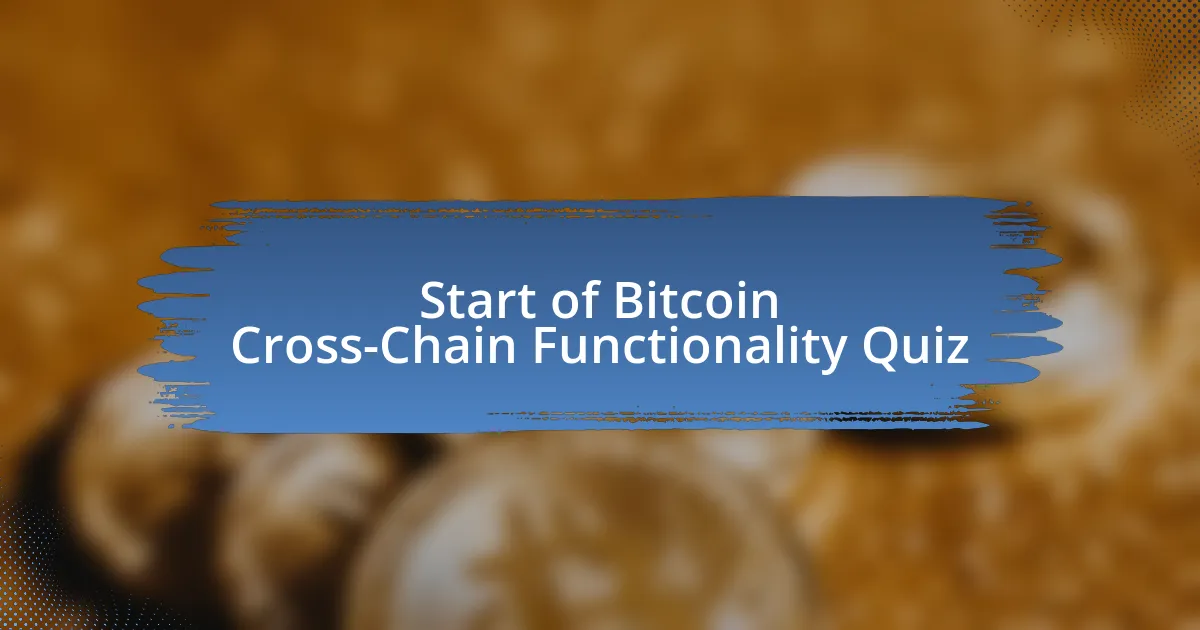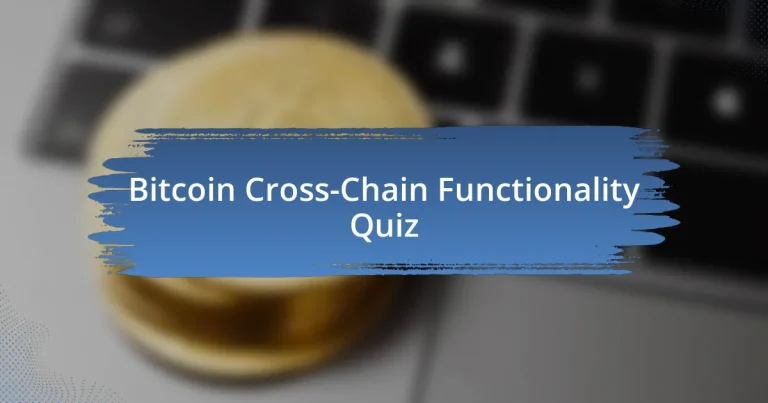
Start of Bitcoin Cross-Chain Functionality Quiz
1. What are cross-chain bridges in the context of Bitcoin technology?
- Cross-chain bridges are tools that only facilitate payments within a single blockchain.
- Cross-chain bridges are protocols that enable the transfer of tokens and data across different blockchains.
- Cross-chain bridges are hardware devices used for storing cryptocurrencies securely.
- Cross-chain bridges are applications that allow for offline cryptocurrency transactions.
2. How does the locking and minting process work in cross-chain bridges?
- Cross-chain bridges work by locking assets on one blockchain and minting equivalent tokens on another blockchain.
- Cross-chain bridges require no involvement of smart contracts to manage asset transfers across blockchains.
- Cross-chain bridges simply transfer tokens without any locking mechanism or minting process.
- Cross-chain bridges convert tokens into fiat currency before moving them to another blockchain.
3. Can you give an example of how Bitcoin can be moved to another blockchain?
- Transferring Bitcoin directly to a centralized exchange.
- Copying Bitcoin to a different cryptocurrency wallet.
- Moving Bitcoin to Ethereum via a cross-chain bridge.
- Selling Bitcoin for Ethereum on a market platform.
4. What is the function of Wrapped Bitcoin (WBTC) in the blockchain ecosystem?
- Wrapped Bitcoin (WBTC) is a new cryptocurrency created by a private company.
- Wrapped Bitcoin (WBTC) is a form of stablecoin pegged to the US dollar.
- Wrapped Bitcoin (WBTC) serves as a bridge for Bitcoin to be used on Ethereum.
- Wrapped Bitcoin (WBTC) is a non-fungible token used for artwork on the blockchain.
5. Describe the process of redeeming original Bitcoin from a cross-chain transaction.
- The process requires sending Bitcoin directly to the Ethereum network without any locks or contracts.
- The process involves burning the WBTC on Ethereum, and the bridge releases the original Bitcoin.
- The process is done by converting Bitcoin into a stablecoin and then transferring it to another blockchain.
- The process entails holding Bitcoin indefinitely on one chain while waiting for approval from a centralized entity.
6. What role do smart contracts play in cross-chain Bitcoin transfers?
- Smart contracts ensure assets are locked and released correctly.
- Smart contracts are only used for transactions within a single blockchain.
- Smart contracts create new assets on the source blockchain.
- Smart contracts eliminate the need for any blockchain infrastructure.
7. What do we mean by cross-chain atomic swaps in cryptocurrency?
- Cross-chain atomic swaps are processes for creating new cryptocurrencies within a single blockchain.
- Cross-chain atomic swaps are systems for storing multiple cryptocurrencies in a single wallet.
- Cross-chain atomic swaps are methods of exchanging different cryptocurrencies directly between two peers without trust or third-party moderation.
- Cross-chain atomic swaps are protocols that facilitate the transfer of tokens between exchanges.
8. How is an atomic swap different from a regular cryptocurrency transaction?
- Atomic swaps only work within the same blockchain for transactions.
- Atomic swaps allow direct exchanges of cryptocurrencies without intermediaries.
- Atomic swaps require a third-party exchange to finalize the transaction.
- Atomic swaps create new tokens in the transaction process.
9. What technology underpins the operation of atomic swaps?
- Hash Timelock Contracts (HTLC)
- Private keys
- Multi-signature wallets
- Centralized exchanges
10. How do Hash Timelock Contracts (HTLC) facilitate secure swaps?
- HTLC eliminates the need for smart contracts entirely.
- HTLC simply tracks transactions on a single blockchain.
- HTLC requires third-party verification for swaps to occur.
- HTLC uses time-bound locks and hashes to ensure secure swaps.
11. Why are atomic swaps considered important in the blockchain realm?
- They increase transaction fees for users.
- They require trust between different blockchains.
- They limit transactions to a single blockchain.
- They remove centralized intermediaries for secure exchanges.
12. What is essential for the successful execution of cross-chain atomic swaps?
- Traditional banking infrastructure
- Centralized exchange authority
- Relative timelock operation
- Single blockchain protocol
13. Explain how cross-chain bridges improve blockchain interoperability.
- Cross-chain bridges serve as a method to secure private keys for blockchain wallets.
- Cross-chain bridges enable asset transfers between different blockchain networks without the need for intermediaries.
- Cross-chain bridges limit users to transactions within the same blockchain network.
- Cross-chain bridges only facilitate trades on centralized exchanges, not on decentralized ones.
14. What security risks are associated with using cross-chain bridges?
- Delayed transaction times
- Increased transaction fees
- Limited asset availability
- Security breaches and hacks
15. How do cross-chain bridges support an interconnected blockchain ecosystem?
- Cross-chain bridges serve as foundational infrastructure for cross-chain swaps, enabling seamless exchange of digital assets between different blockchain networks.
- Cross-chain bridges only allow the trading of assets on a single blockchain without connections to others.
- Cross-chain bridges create a new cryptocurrency that cannot interact with other tokens outside its network.
- Cross-chain bridges exclusively operate by locking all assets in one central location for security reasons.
16. What role do centralized exchanges play in cross-chain transactions?
- Centralized exchanges only allow trading on a single blockchain network.
- Centralized exchanges do not facilitate token transfers between different blockchain ecosystems.
- Centralized exchanges manage the cross-chain transaction process by taking custody of funds.
- Centralized exchanges eliminate the need for any blockchain interaction.
17. Define decentralized exchanges (DEX) within single blockchain contexts.
- A DEX is a type of blockchain that allows only peer-to-peer transactions without any additional functionalities.
- A DEX is a platform that relies on centralized order books for trading cryptocurrencies efficiently.
- A DEX is a specialized wallet used for storing digital assets securely on various blockchains.
- A DEX is a platform where users can trade assets within a single blockchain network without the need for centralized intermediaries.
18. How do cross-chain DEXs differ from traditional DEXs in functionality?
- Cross-chain DEXs only support tokens from a single blockchain.
- Cross-chain DEXs require users to convert tokens before trading.
- Cross-chain DEXs operate solely within centralized platforms.
- Cross-chain DEXs allow trading of assets from multiple blockchains seamlessly.
19. Can you provide an example of executing trades across different blockchains?
- Converting Bitcoin to a stablecoin on a DEX.
- Transferring Ethereum to Litecoin on a centralized exchange.
- Moving Bitcoin to Ethereum using a cross-chain bridge.
- Selling Bitcoin for cash and buying Ethereum.
20. Why is the value peg crucial between original and wrapped tokens?
- The value peg allows wrapped tokens to be sold for profit.
- The value peg ensures that wrapped tokens equal the original ones.
- The value peg creates new coins for trading.
- The value peg only regulates transaction fees.
21. How do cross-chain bridges maintain the equal supply of tokens?
- Cross-chain bridges lock and release assets to maintain token supply.
- Cross-chain bridges duplicate tokens on each blockchain for supply maintenance.
- Cross-chain bridges adjust token prices dynamically to maintain supply.
- Cross-chain bridges merge blockchains to consolidate token supply.
22. What process is referred to as `minting` in cross-chain transactions?
- Locking
- Burning
- Redeeming
- Minting
23. What is meant by `burning` tokens in a cross-chain context?
- The process of eliminating tokens on the source blockchain to facilitate cross-chain transactions.
- Increasing the number of tokens in existence across various chains.
- Creating tokens on multiple blockchains without restrictions.
- Transferring tokens directly without any security measures.
24. How do smart contracts manage data transfer in cross-chain protocols?
- Cross-chain bridges require manual intervention for every data transfer.
- Cross-chain bridges only transfer tokens without managing any data.
- Cross-chain bridges exchange assets without using any smart contracts.
- Cross-chain bridges handle data transfer using smart contracts to manage asset locking and releasing.
25. Describe the primary function of cross-chain bridges in the cryptocurrency ecosystem.
- Create exclusive tokens that only exist on one blockchain.
- Store data solely within a single blockchain network.
- Enable the transfer of tokens and data across different blockchains.
- Facilitate the mining of new cryptocurrencies in one chain.
26. Differentiate between cross-chain bridges and atomic swaps.
- Cross-chain bridges are limited to a single blockchain, whereas atomic swaps operate across many blockchains.
- Cross-chain bridges require a centralized intermediary for trading, while atomic swaps do not.
- Cross-chain bridges involve locking assets to create equivalent tokens, while atomic swaps directly exchange them.
- Cross-chain bridges directly exchange cryptocurrencies without any equivalents, while atomic swaps lock assets.
27. What is the main purpose of Hash Timelock Contracts in secure transactions?
- To increase transaction fees for users in the network.
- To provide a central authority for transaction validation.
- To create new cryptocurrencies with unique identities.
- To automate secure exchanges across blockchains.
28. How do atomic swaps achieve the all-or-nothing principle in exchanges?
- Atomic swaps use smart contracts and HTLC for conditional release.
- Atomic swaps require trust in a third party to execute the exchange process.
- Atomic swaps are executed solely through centralized exchanges without smart contracts.
- Atomic swaps rely on manual escrow services to manage transactions.
29. What benefits arise from using Hash Timelock Contracts during swaps?
- It allows direct trading on exchanges.
- It reduces network fees across platforms.
- It ensures secure and trustless exchanges.
- It improves transaction speeds significantly.
30. Identify requirements for executing cross-chain atomic swaps successfully.
- All involved parties must be registered on a centralized exchange for validation.
- Both chains need some kind of relative timelock operation and the ability to hash a blob of data and check against a given hash.
- Each blockchain must be able to monitor all transactions occurring on the other chain.
- Both chains must be on the same blockchain network and can freely exchange data.

Quiz Successfully Completed!
Congratulations on completing the quiz on Bitcoin Cross-Chain Functionality! You’ve tested your knowledge and likely gained valuable insights along the way. Quizzes like this one not only assess your understanding but also help reinforce key concepts in the exciting world of blockchain technology.
Throughout the quiz, you may have learned about critical aspects such as how Bitcoin interacts with other blockchains. Understanding cross-chain functionality enhances your awareness of interoperability solutions and the future of cryptocurrency transactions. These insights are crucial for anyone looking to navigate the evolving landscape of digital currencies.
To deepen your understanding further, we invite you to explore the next section on this page. It offers comprehensive information on Bitcoin Cross-Chain Functionality. Dive in and expand your knowledge even more to stay ahead in the rapidly changing world of crypto!

Bitcoin Cross-Chain Functionality
Understanding Bitcoin Cross-Chain Functionality
Bitcoin cross-chain functionality refers to the ability of Bitcoin to interact with other blockchain networks. This capability allows users to transfer value or data between Bitcoin and other cryptocurrencies seamlessly. Cross-chain operations enable greater liquidity and accessibility in the cryptocurrency ecosystem, promoting interoperability among different blockchain protocols.
Mechanisms Enabling Bitcoin Cross-Chain Transactions
Several mechanisms facilitate Bitcoin cross-chain transactions, including atomic swaps and wrapped tokens. Atomic swaps enable direct peer-to-peer exchanges between different cryptocurrencies without the need for intermediaries. Wrapped tokens, like WBTC (Wrapped Bitcoin), are Bitcoin tokens that exist on other blockchains, allowing users to leverage Bitcoin’s value within those ecosystems.
Benefits of Bitcoin Cross-Chain Compatibility
The primary benefit of Bitcoin cross-chain compatibility is enhanced flexibility within the cryptocurrency market. Users can diversify their investments and utilize Bitcoin in decentralized finance (DeFi) applications on other platforms. This functionality also reduces the need to rely on centralized exchanges for conversions, decreasing transaction fees and time delays.
Challenges in Implementing Bitcoin Cross-Chain Solutions
Implementing Bitcoin cross-chain solutions presents challenges such as security, scalability, and user experience. Ensuring secure transfers across different chains involves complex protocols and smart contract execution. Scalability issues may arise if a high volume of cross-chain transactions occurs simultaneously, potentially affecting network performance.
Future of Bitcoin Cross-Chain Functionality
The future of Bitcoin cross-chain functionality looks promising with continued advancements in blockchain technology. Innovations like decentralized bridges and layer-2 solutions aim to enhance interoperability. As more projects focus on cross-chain capabilities, the overall integration of Bitcoin within the broader crypto ecosystem is expected to improve significantly.
What is Bitcoin Cross-Chain Functionality?
Bitcoin Cross-Chain Functionality refers to the capability of Bitcoin to interact and transfer value or data across different blockchain networks. This functionality is facilitated through various mechanisms such as atomic swaps and cross-chain bridges, which allow users to exchange Bitcoin with assets on other blockchains without relying on centralized exchanges. According to a 2023 study by Chainalysis, these cross-chain methods enhance interoperability and liquidity in the broader cryptocurrency ecosystem.
How does Bitcoin Cross-Chain Functionality work?
Bitcoin Cross-Chain Functionality works by utilizing specific protocols that allow the transfer of assets between different blockchains. This often involves locking the Bitcoin in a smart contract on the original chain while creating a corresponding representation of that Bitcoin on the destination chain. Atomic swaps enable direct peer-to-peer exchanges by using hashed timelock contracts, ensuring that transactions are either completed fully or not at all. The scalability of this approach, by 2023, showed a revolutionary increase in cross-chain transactions, demonstrating the growing adoption of such technologies.
Where can Bitcoin Cross-Chain Functionality be applied?
Bitcoin Cross-Chain Functionality can be applied in various areas, including decentralized finance (DeFi), trading platforms, and asset management tools. DeFi protocols leverage cross-chain functionality to enable users to transact with Bitcoin while utilizing features from other blockchain ecosystems like Ethereum. Reports from DeFi Pulse indicate that the integration of Bitcoin into DeFi platforms increased the total value locked (TVL) in cross-chain assets by over 40% in 2022, illustrating its practical applications.
When did Bitcoin Cross-Chain Functionality become relevant?
Bitcoin Cross-Chain Functionality became relevant around 2017, with the introduction of atomic swaps. These swaps allowed users to trade Bitcoin for other cryptocurrencies directly between peers without intermediaries. The relevance further grew in 2020 with the emergence of cross-chain bridges, facilitating more seamless interactions across diverse blockchain networks. By 2023, this functionality had gained significant traction in the cryptocurrency market, evidenced by the rise of cross-chain DeFi projects.
Who benefits from Bitcoin Cross-Chain Functionality?
Various stakeholders benefit from Bitcoin Cross-Chain Functionality, including individual cryptocurrency users, traders, and developers. Users gain increased flexibility in transacting across networks without needing centralized exchanges. Traders benefit from enhanced liquidity and arbitrage opportunities between different assets on various chains. Developers leverage this functionality to create innovative decentralized applications (dApps) that enhance user experiences. The increasing number of cross-chain applications, reported by DappRadar, highlights the expanding benefits across the ecosystem.


